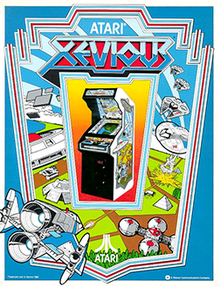| Xevious | |
|---|---|
 North American arcade flyer | |
| Developer(s) | Namco |
| Publisher(s) |
|
| Designer(s) | Masanobu Endō Shigeki Toyama |
| Artist(s) | Hiroshi Ono[2] |
| Composer(s) | Yuriko Keino |
| Series | Xevious |
| Platform(s) | Arcade, Apple II, Atari 7800, Atari ST, NES, Famicom Disk System, Commodore 64, Amstrad CPC, X68000, ZX Spectrum, Mobile phone, Game Boy Advance, Xbox 360 |
| Release | |
| Genre(s) | Scrolling shooter |
| Mode(s) | Single-player, multiplayer |
| Arcade system | Namco Galaga |
Xevious[a] is a vertically scrolling shooter arcade video game developed and published by Namco in 1982. It was released in Japan by Namco and in North America by Atari, Inc. Controlling the Solvalou starship, the player attacks Xevious forces before they destroy all of mankind. The Solvalou has two weapons at its disposal: a zapper to destroy flying craft, and a blaster to bomb ground installations and enemies. It runs on the Namco Galaga arcade system.
The game was designed by Masanobu Endō and a small team. Created to rival the success of Scramble, it was originally themed around the Vietnam War and titled Cheyenne. Endō wanted the game to have a detailed, integral storyline and a comprehensive world, and to be welcoming for newer players. Several enemies and characters were made to pay homage to other popular science fiction works, including Star Wars, UFO, Alien, and Battlestar Galactica.
Xevious was praised for its detailed graphics, challenge, and originality. It became an unprecedented success for Namco in Japan, with record-breaking sales figures making it the biggest game since Space Invaders. The North American release paled in comparison, despite still selling 5,295 arcade units by the end of 1983. It has been listed among the greatest video games of all time and one of the most influential games in the shoot 'em up genre, establishing the template for vertically scrolling shooters and inspiring games such as TwinBee and RayForce. It was ported to home systems, followed by several sequels and spin-offs, and is included in many Namco compilations.
- ^ Akagi, Masumi (October 13, 2006). アーケードTVゲームリスト国内•海外編(1971-2005) [Arcade TV Game List: Domestic • Overseas Edition (1971-2005)] (in Japanese). Japan: Amusement News Agency. pp. 52, 84. ISBN 978-4990251215.
- ^ Kiya, Andrew (October 17, 2021). "Former Namco Pixel Artist Hiroshi 'Mr. Dotman' Ono Has Died". Siliconera. Retrieved October 17, 2021.
Cite error: There are <ref group=lower-alpha> tags or {{efn}} templates on this page, but the references will not show without a {{reflist|group=lower-alpha}} template or {{notelist}} template (see the help page).